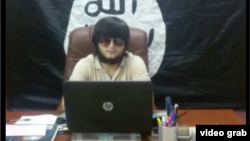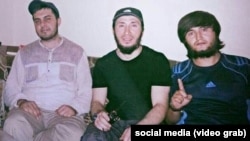The concept of "martyrdom," death in battle against "infidels," is a key element of the ideology of the Islamic State (IS) militant group. IS disseminates photographs of dead militants online, proudly hailing them as "martyrs" in propaganda efforts.
But authorities in Tajikistan suspect a 28-year-old Tajik militant who goes by the nom de guerre Abu Daoud Tochiki used social media to deliberately spread news of his "death" in Syria, according to RFE/RL's Tajik Service, Radio Ozodi.
And there might be others.
Dead Or Alive?
Abu Daoud -- whose real name is Parviz Saidrakhmonov and who hails from Microdistrict 102 on the outskirts of the Tajik capital, Dushanbe -- was declared dead in social-media posts in late June.
Saidrakhmonov, the accounts said, was killed in the same attack that wounded former Tajik OMON commander Gulmurod Halimov, who defected to IS earlier this year.
The story began on June 22, when rumors that Halimov had been killed in Iraq spread like wildfire on social media.
The reports started in the Lebanese newspaper Arabi-Press, which claimed Halimov had died in a Syrian Army strike in Deir al-Zor Province. Halimov, the story said, had been with IS military commander Umar al-Shishani when the strike occurred.
The rumors of Halimov's death turned out to be false, or at least highly exaggerated. By June 23, photos of former OMON commander emerged on social media showing him to be merely injured.
The posts declaring Saidrakhmonov's death emerged a day later when a "martyr video" with photos of Saidrakhmonov and other militants said to be killed was posted on YouTube. The video includes images of a bloody corpse that is possibly alleged to be Saidrakhmonov's. The video did not say when or where Saidrakhmonov had died.
Why Fake It?
If Saidrakhmonov really is still alive, why would IS militants post false information about his death?
Muzaffar Yusufi of Tajikistan's Prosecutor-General's Office told Radio Ozodi that Tajik militants like Asomiddinov may "play dead" in order to stop the country's security forces from interrogating their relatives.
When a Tajik citizen is thought to have joined IS, investigators question his family members, Yusufi told Radio Ozodi. "When [the family] announces that the young man died in clashes and take the appropriate measures at home and invite people to a funeral, the investigation stops any further visits to those people's home," he added.
Faked deaths have been known to be carried out, Yusufi said.
In April, a photograph of 23-year-old Sukhrob Asomiddinov, an IS militant from Rudaki in western Tajikistan, circulated on social media with the claim that he had been "martyred."
The photograph shows Asomiddinov lying on his back with his eyes closed, apparently dead.
But in June, Asomiddinov was spotted in an IS video and he was definitely alive, at least temporarily: the Tajik militant was filmed blowing himself up in an attack against Kurdish militia fighters.
Yusufi said such militants are "the victims of IS ideology," brainwashed by the militant group to carry out atrocities.
"These guys are stupid and gullible and they are being gathered together in Syria and Iraq from all over the world in order to carry out the terrorists' dirty plans," he added.
Could this be what happened to Saidrakhmonov?
Although there has been no official verification of his death, Saidrakhmonov's family held a wake for him on June 27.
But his sister, Anora Saidrakhmonova, told Radio Ozodi that she does not yet believe her brother is dead.
The family got the news over social media, Anora said. Before that Saidrakhmonov had not been in touch with his family since May 25.
The Red Bull Fan With Three Wives
Who is -- or was -- Saidrakhmonov?
Anora remembered him as a young man with a troubled private life.
Saidrakhmonov married three times, twice in Tajikistan and once in Russia. He had three children with his Tajik wives and a 3-month-old baby with his Russian spouse.
But he was not happy.
"He was very dissatisfied with his personal life," Anora said. "His first wife turned out to be a junkie. He didn't get along with his second wife."
It was after Saidrakhmonov went to live in Russia that he became "completely absorbed in ideas of jihad," Anora said.
"He didn't want to think about anything else. He told [his Russian wife] that he was prepared to die and even if all his relatives in Tajikistan were killed he would never come back here."
Then Saidrakhmonov joined IS. He went to Iraq a year ago from Russia. His family only found out on February 6, when he called home.
Apart from his unhappy private life, not much is known about Saidrakhmonov's life in Tajikistan before he was radicalized. The few details that have emerged are ordinary, even banal.
While still living in Dushanbe, Saidrakhmonov got interested in fitness and joined a local gym. A former acquaintance there, Alisher Safarov, told Radio Ozodi that there was nothing special about Saidrakhmonov.
"I remember he was very fond of [the energy drink] Red Bull," Safarov recalled, "and when he didn't have the money to buy it he would ask others for cash to buy that drink."
Safarov remembered seeing an IS video in which his former gym buddy was eating shashlik and remarking how delicious it was.
"He liked to eat tasty food, and he thought about that all the time. When I saw the video I immediately said that he went to Iraq so he could eat tasty food," Safarov said.
"But as they say, the only place you get free cheese is in a mousetrap."
The Death Pledge
Apart from eating shashlik, during his time in IS-controlled territory Saidrakhmonov appears to have occupied a somewhat privileged position in a core group linked to senior figures in IS's Russian-speaking faction.
The Tajik was frequently photographed alongside prominent individuals including the defected Tajik OMON commander Halimov and two Daghestani preachers, Akhmad Medinsky and Nadir Abu Khalid, both of whom are now playing key roles in IS North Caucasian-led groups.
Photographs in Saidrakhmonov's "martyr video" suggest he was employed as a media activist in IS's propaganda efforts. Several pictures show him sitting at a desk in an office and working on a laptop.
IS has also used Saidrakhmonov to promote the group's ideology of martyrdom in its official propaganda efforts. The Tajik militant appears in a recruitment and propaganda video released in May by Furat Media, now IS's official Russian language media wing.
It shows a group of Russian-speaking militants undergoing training as a special "death squad" and taking a special pledge to fight to the death. The video includes speeches by prominent IS ideologue Abu Jihad -- an ethnic Karachay and close confidante of Umar al-Shishani -- and Daghestani preacher Medinsky.
Most of the militants featured in the video were killed in an April 25 attack in Iraq.
So while Saidrakhmonov's sister Anora still believes her brother is alive, to IS it really doesn't matter.
The Tajik has already been a useful tool in promoting IS's death cult.





